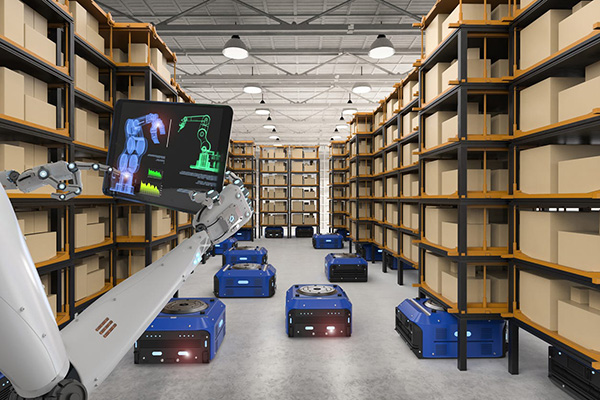The digital age has set the stage for a colossal shift in warehousing paradigms. At the heart of this transformation lies automation — a beacon of innovation enabling warehouses to transcend traditional limitations and redefine efficiency. This article delves into the game-changing technologies shaping the warehouse of tomorrow and illustrates the tangible benefits businesses can reap from this technological renaissance.
Pioneering Technologies in Warehousing Automation
A. Next-Gen Conveyor Systems:
Once rudimentary tools, conveyor systems have evolved into intricate networks of material movement, thanks to automation. Modern warehouses now harness advanced conveyor solutions to ensure an uninterrupted and rapid flow of goods.
Current complex conveyor automation systems employ a suite of modules, including automatic scanning, weighing, and dimensioning modules for inbound goods auto GRN. These modules can be seamlessly integrated with a variety of complementary functionalities, such as auto-packaging systems and auto-labellers, and can be further enhanced with advanced sorting modules, such as swivel wheel, pop-up, and linear arm sorters.
Traditional roller conveyors are being replaced by flexible modular systems that can adapt to changing product sizes, shapes, and weights. These systems use a combination of powered rollers, diverters, and robotics to sort items efficiently and accurately, even at high speeds.
From loading to distribution, these systems exemplify efficiency, ensuring businesses stay ahead of the curve in a dynamic market landscape.
B. ASRS – The Backbone of Advanced Storage:
The Automated Storage and Retrieval Systems (ASRS) epitomize the “Goods to Person” paradigm. These are not merely storage solutions but intelligent ecosystems comprising robotic systems and state-of-the-art software. Especially noteworthy are the 3D ASRS systems that leverage robotics, setting new benchmarks for speed and adaptability.
3D ASRS effectively utilizes vertical space, significantly increasing storage density compared to traditional 2D systems. This reduces floor space requirements and real estate costs, making it ideal for warehouses with limited space. Additionally, 3D ASRS enhances order-picking efficiency by allowing robots to retrieve items from any location in the racking structure, eliminating manual aisle traversal.
3D ASRS are particularly well-suited for warehouses with limited floor space or those that handle a high volume of inventory. They are also ideal for storing high-value or sensitive items that require secure storage and controlled access.
C. AGVs and AMRs – Mobility Redefined:
AGVs and AMRs are transforming warehousing dynamics. While AGVs bring consistency and reliability, AMRs, equipped with advanced sensors, bring adaptability and perfect maneuvering through ever-changing warehouse landscapes. These mobile marvels amplify efficiency, making them indispensable assets for future-ready warehouses.
These robotic vehicles navigate warehouse aisles independently, transporting goods and materials without the need for human intervention. AGVs follow predetermined paths using sensors and guidance systems, while AMRs use sophisticated algorithms to map their environment and make autonomous decisions about their routes.
They are used in a wide variety of applications, including pallet transportation, order picking, inventory management, goods-to-person (GTP), and sorting and distribution. Both AGVs and AMRs offer a variety of benefits for warehouse operations, including increased efficiency and productivity, improved safety, enhanced flexibility, and reduced costs.
AGVs and AMRs are a valuable asset for any warehouse looking to optimize its operations and improve its bottom line.
D. IoT – The Pulse of the Smart Warehouse:
IoT sensors are the eyes and ears of the modern warehouse. They empower managers with real-time insights, from inventory levels to environmental conditions, facilitating data-driven decisions that optimize efficiency and agility.
This interconnected ecosystem facilitates real-time inventory tracking, asset tracking and monitoring, predictive maintenance, and enhanced safety. Real-time inventory tracking ensures accurate stock levels and timely replenishment, preventing stockouts. Asset tracking optimizes resource allocation and reduces downtime.
Predictive maintenance proactively identifies potential equipment failures, minimizing disruptions. Enhanced safety features detect and alert personnel to potential hazards, preventing accidents and injuries.
IoT is transforming warehouse automation, making it more efficient, productive, and safe. It’s a testament to the power of connectivity and data in optimizing warehouse operations.
E. AI/ML – The Brain Behind the Operation:
No longer confined to sci-fi, AI and ML are now the nerve centers of automated warehouses. By processing vast data streams, these algorithms optimize every facet of warehousing, from inventory forecasting to order routing, ushering in an era of predictive and proactive warehousing.
By utilizing AI and ML algorithms, predictive analytics can analyze past data and forecast future demand, which leads to more efficient inventory management. Additionally, AI-powered routing and dynamic scheduling have made Automated Storage and Retrieval Systems (ASRS) more reliable.
Machine learning algorithms have also played a crucial role in predictive maintenance, reducing the downtime of automated machinery. In warehouse robotics, AI enables robots to make decisions in real-time, allowing them to navigate and interact with the environment autonomously.
Overall, AIML has streamlined operations, reduced costs, and increased the agility and responsiveness of supply chain processes.
F. Robotics – Crafting the Future:
Robotics in warehousing is more than a trend; it’s a revolution. These aren’t just machines but enablers of a visionary future where precision, speed, and adaptability coalesce. As robotics pave the way for seamless global commerce, they underscore the transformative power of innovation in warehousing.
These robots are used in material handling, where Automated Guided Vehicles (AGVs) and Autonomous Mobile Robots (AMRs) can transport goods with great efficiency, reducing the need for manual labor. Robotic arms are used to automate picking and packing processes, thus accelerating order fulfillment.
Collaborative robots, or cobots, work alongside human workers, improving efficiency in tasks that require dexterity and precision. Additionally, robotic systems contribute to inventory management, ensuring accurate tracking and timely restocking.
Overall, the integration of robotics in warehouse automation optimizes processes, minimizes errors, and boosts productivity, establishing a more agile and responsive supply chain ecosystem.
Tangible Outcomes of Warehouse Automation:
1. Peak Efficiency: Automation turbocharges operations, allowing warehouses to handle more with less, ensuring they’re always a step ahead.
2. Precision Perfected: The margin for human error is diminished, resulting in superior accuracy and enhanced customer trust.
3. Economic Wisdom: Though the upfront investment might appear steep, the long-term ROI through cost savings and efficiency is unparalleled.
4. Agile Scalability: Automation empowers warehouses to swiftly pivot as per demand surges or declines, ensuring business continuity.
5. Safety Sanctified: Automation shoulders the heavy lifting, significantly minimizing workplace hazards and fostering a culture of safety.
6. Data-Driven Mastery: With real-time data at their fingertips, businesses can fine-tune strategies and harness their warehousing prowess.
The nexus of automation technologies is reshaping the warehousing sector, and this metamorphosis is just the beginning. As we journey further into this digital era, those who harness the power of automation will lead, setting new benchmarks and redefining excellence in global logistics.














